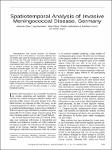Spatiotemporal Analysis of Invasive Meningococcal Disease, Germany
Elias, Johannes
Harmsen, Dag
Claus, Heike
Hellenbrand, Wiebke
Frosch, Matthias
Vogel, Ulrich
Meningococci can cause clusters of disease. Specimens from 1,616 patients in Germany obtained over 42 months were typed by serogrouping and sequence typing of PorA and FetA and yielded a highly diverse dataset (Simpson's index 0.963). A retrospective spatiotemporal scan statistic (SaTScan) was applied in an automated fashion to identify clusters for each finetype defined by serogroup variable region (VR) VR1 and VR2 of the PorA and VR of the FetA. A total of 26 significant clusters (p< or =0.05) were detected. On average, a cluster consisted of 2.6 patients. The median population in the geographic area of a cluster was 475,011, the median cluster duration was 4.0 days, and the proportion of cases in spatiotemporal clusters was 4.2%. The study exemplifies how the combination of molecular finetyping and spatiotemporal analysis can be used to assess an infectious disease in a large European country.
Dateien zu dieser Publikation
Keine Lizenzangabe

